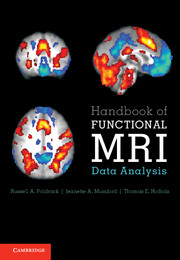Book contents
- Frontmatter
- Contents
- Preface
- 1 Introduction
- 2 Image processing basics
- 3 Preprocessing fMRI data
- 4 Spatial normalization
- 5 Statistical modeling: Single subject analysis
- 6 Statistical modeling: Group analysis
- 7 Statistical inference on images
- 8 Modeling brain connectivity
- 9 Multivoxel pattern analysis and machine learning
- 10 Visualizing, localizing, and reporting fMRI data
- Appendix A A Review of the General Linear Model
- Appendix B Data organization and management
- Appendix C Image formats
- Bibliography
- Index
3 - Preprocessing fMRI data
Published online by Cambridge University Press: 01 June 2011
- Frontmatter
- Contents
- Preface
- 1 Introduction
- 2 Image processing basics
- 3 Preprocessing fMRI data
- 4 Spatial normalization
- 5 Statistical modeling: Single subject analysis
- 6 Statistical modeling: Group analysis
- 7 Statistical inference on images
- 8 Modeling brain connectivity
- 9 Multivoxel pattern analysis and machine learning
- 10 Visualizing, localizing, and reporting fMRI data
- Appendix A A Review of the General Linear Model
- Appendix B Data organization and management
- Appendix C Image formats
- Bibliography
- Index
Summary
Introduction
Just as music recorded in a studio requires mixing and editing before being played on the radio, MRI data from the scanner require a number of preprocessing operations in order to prepare the data for analysis. Some of these operations are meant to detect and repair potential artifacts in the data that may be caused either by the MRI scanner itself or by the person being scanned. Others are meant to prepare the data for later processing stages; for example, we may wish to spatially blur the data to help ensure that the assumptions of later statistical operations are not violated. This chapter provides an overview of the preprocessing operations that are applied to fMRI data prior to the analyses discussed in later chapters. The preprocessing of anatomical data will be discussed in Chapter 4.
In many places, the discussion in this chapter assumes basic knowledge of the mechanics of MRI data acquisition. Readers without a background in MRI physics should consult a textbook on MRI imaging techniques, such as Buxton (2002).
An overview of fMRI preprocessing
Preprocessing of fMRI data varies substantially between different software packages and different laboratories, but there is a standard set of methods to choose from. Figure 3.1 provides an overview of the various operations and the usual order in which they are performed. However, note that none of these preprocessing steps is absolutely necessary in all cases, although we believe that quality control measures are mandatory.
- Type
- Chapter
- Information
- Handbook of Functional MRI Data Analysis , pp. 34 - 52Publisher: Cambridge University PressPrint publication year: 2011
- 2
- Cited by



